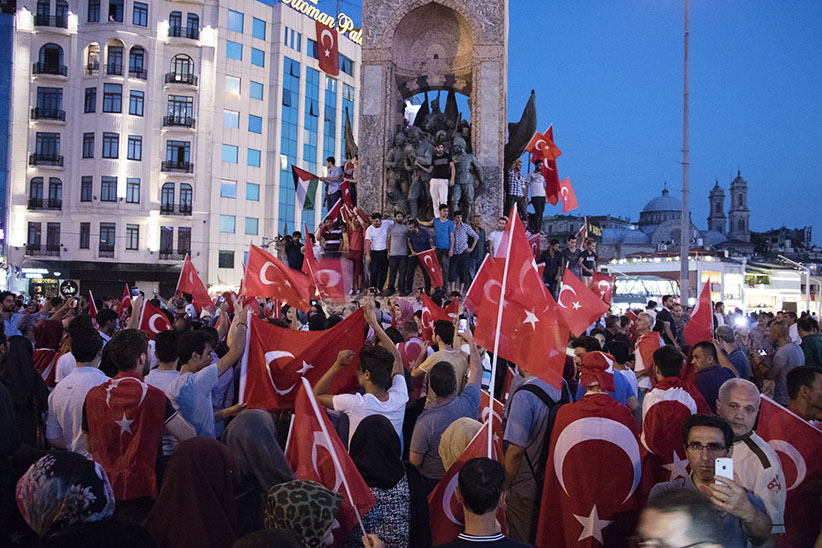It’s time to stop idolizing historical figures altogether
Opinion: Turkey’s mutable Republic Monument poses a stark question—why do countries even award places of honour to historical figures?
The day after a failed coup attempt in Turkey, supporters of President Recep Tayyip Erdogan and his AK Party gather at Taksim Square for a “Democracy festival”, climbing onto the iconic monument of Mustafa Kemal Ataturk, modern Turkey’s founder. The fallout from the failed coup has left Turkey more divided than ever between Islamists and secularists. (Photograph by Adnan Khan)
Share

The Republic Monument, perched in the centre of Istanbul, in the heart of Turkey’s most iconic square, Taksim, is political by its very nature. Commissioned by Mustafa Kemal Ataturk in 1926, it was designed and built in Rome, by Italian artist Pietro Canonica, and paid for by donations from the Turkish people. It features two tableaux facing in opposite directions, both commemorating the founding of the Turkish Republic in 1923. The one side shows Ataturk, the war hero and father of modern Turkey, dressed in military fatigues, leading his war-weary generals into battle. The opposite side depicts Ataturk after the revolution, dressed in western clothes, at the head of equally well-heeled luminaries, as they set to work realizing the secular vision of the New Turkey.
History, though, has not been kind to him. Like so many great figures, adoration for Ataturk is accompanied by a reciprocal loathing. For some, his ruthless secularization programs were not only necessary but instrumental in saving Turkey from the chaos engulfing the Middle East today. To others, he was a despot who imposed his secular worldview whether you liked it or not, forcing men to remove the fez and women to uncover their heads. He accomplished a truly heroic feat in 1923, saving a dying empire from itself, but at the same time ensured millions of his citizens—ethnic Kurds, Alevis, Greeks and Armenians—would be denied the right to speak their language or practice their culture in the name of promoting a singular Turkish identity.
Since it was erected, the Republic Monument has stood watch over Ataturk’s nation-building mission. Stone-faced, the man at its centre has come to mean different things to different people at different times, his place in history amended, like a repurposed meme, with every capricious permutation in the political landscape. Today, Turkey has moved away from Ataturk’s radically secular ideal. It has turned its face away from the west and is looking back to reclaim the glories of its Ottoman past.
But that could change again next week, or in a month from now, or in a decade. It will almost certainly change at some point in the future, if we are to believe the timeless adage that there is no constant in this world except change. And when the context changes again, so will the meaning of Ataturk.
That’s the problem with statues made in the likeness of men (and women, for that matter): even edified in stone, humans can never shake the ambiguity of being human. Their memories will be used by some to promote one vision of the world and by others to promote another. Despots and revisionists will take their legacies hostage, obscure the darkness, and shine light on whatever serves their purposes.
Great men like Ataturk are condemned to be both heroes and villains, depending on who is telling their story. Their deeds are what made them great, but great deeds invariably produce their share of victims. I’ve seen monuments to great men—and it’s almost always men—scattered around the world. I’ve seen them go up and I’ve witnessed them being torn down. I’ve seen colossal stone faces so badly shot up by automatic gunfire that they look more like monuments to a smallpox outbreak than a memory of heroism.
Still they go up, a fact that always strikes me as either arrogant, ignorant, or tenaciously aristocratic. On the rare occasion it seems warranted—a statue of Terry Fox, or Emily Carr, for instance—I wonder what those being immortalized would think. Would they be appalled or secretly pleased? Would their contributions to the world be remembered the way they intended them to be or could they, like Ataturk, fall victim to history’s whims?
In advanced democracies like Canada, it seems almost vulgar to continue on with idolizing historical figures. Hero worship has always been the domain of authoritarian regimes and dictatorships. But in a country where the rule of law prevails over individuals, institutions over leaders, it is values we should glorify; we should be consigning great personages to the history books. Only there can they be fully fleshed out, in both deeds and misdeeds—not immortalized in stone, where they harden into dogma.
In Turkey, dogmas clashed violently on the night of Jul. 15, 2016. A coup attempt led by army officers opposed to President Recep Tayyip Erdogan, including those loyal to his Islamist rival Fethullah Gulen, along with a coterie of disgruntled secularists, shook the foundations of Turkey’s fledgling democracy. Tens of thousands of Erdogan supporters marched onto the streets to confront the putschists and occupy major landmarks. The coup was defeated and for two weeks Taksim became the epicentre of a mass mobilization of Islamist street power. Every night, the square was transformed into a sea of flags, mostly Turkish but sprinkled here and there with the banners of Palestine, Egypt, Afghanistan, and Saudi Arabia.
Dozens of men scaled the Republic Monument nightly, celebrating atop the secular figure with shouts of “Allahu Akbar!” and chants of Erdogan’s name. One used Ataturk’s head as a footrest. Secularism, the foundational principle of the Turkish Republic, never seemed as fragile as it did those nights. People celebrated the dawn of a New Turkey, led by a new Great Leader.
Ataturk watched it all unfold, stone-eyed and unblinking.